Management Accounting: Financial Reporting Systems, Costing Methodologies, and Income Statement Formulation
VerifiedAdded on 2023/06/18
|16
|3825
|463
AI Summary
This article discusses financial reporting systems, costing methodologies, and income statement formulation in management accounting. It covers the benefits and drawbacks of planning techniques in budgeting process and measures to address financial problems. The article also explains the difference between financial and management accounting and the various types of accounting systems. The subject is management accounting and the course code is not mentioned. The content is relevant for students pursuing management courses in any college or university.
Contribute Materials
Your contribution can guide someone’s learning journey. Share your
documents today.
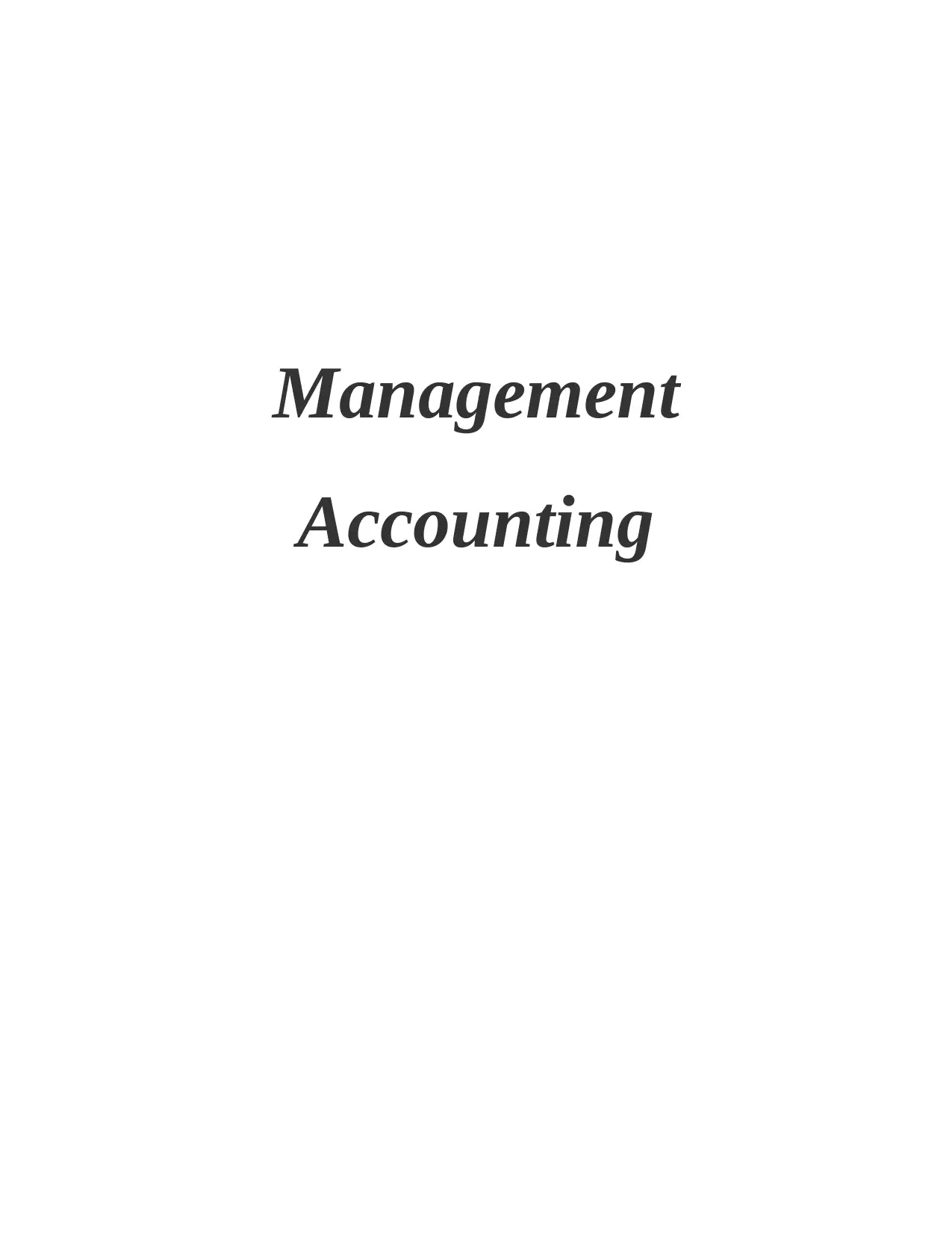
Management
Accounting
Accounting
Secure Best Marks with AI Grader
Need help grading? Try our AI Grader for instant feedback on your assignments.

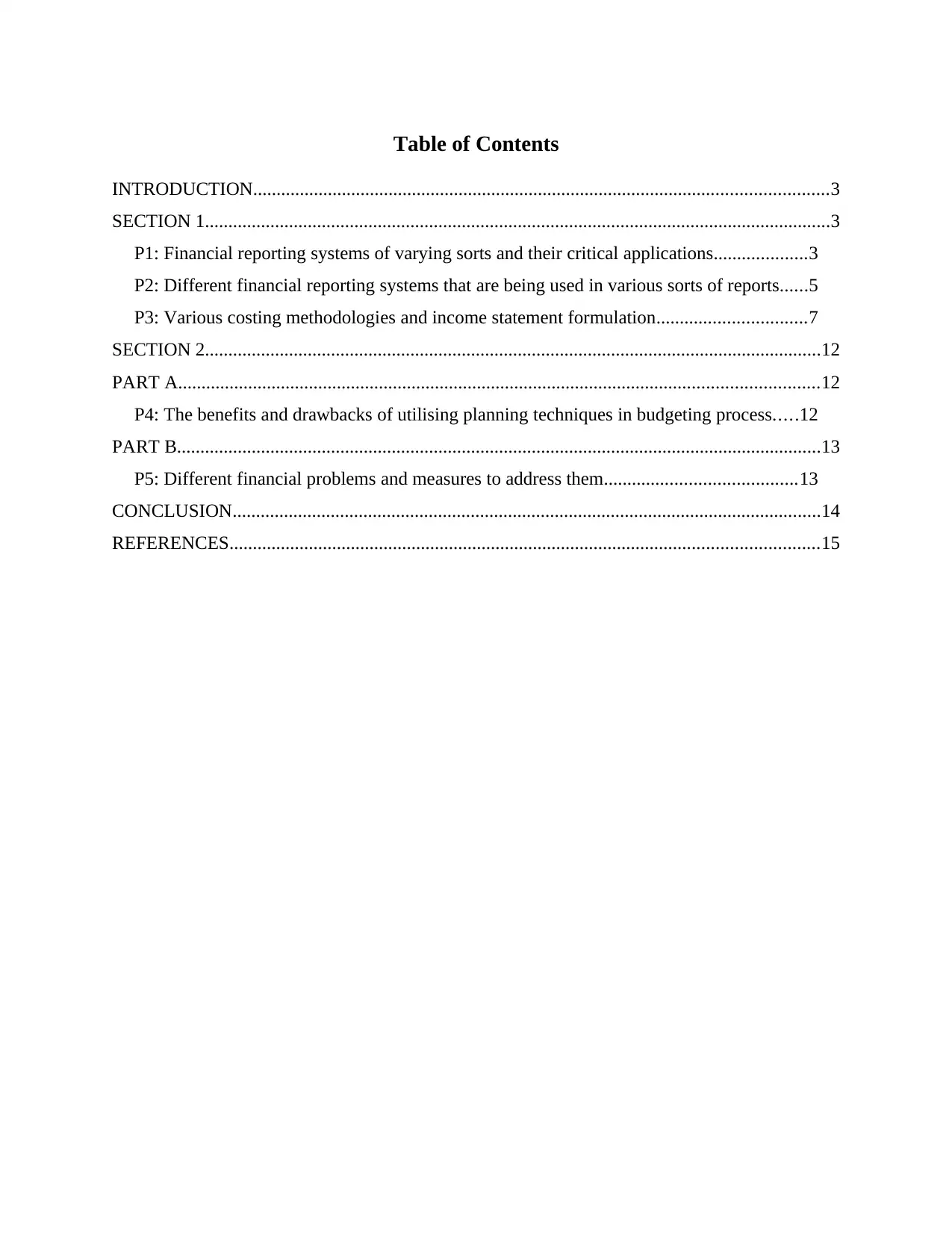
Table of Contents
INTRODUCTION...........................................................................................................................3
SECTION 1......................................................................................................................................3
P1: Financial reporting systems of varying sorts and their critical applications....................3
P2: Different financial reporting systems that are being used in various sorts of reports......5
P3: Various costing methodologies and income statement formulation................................7
SECTION 2....................................................................................................................................12
PART A.........................................................................................................................................12
P4: The benefits and drawbacks of utilising planning techniques in budgeting process.....12
PART B..........................................................................................................................................13
P5: Different financial problems and measures to address them.........................................13
CONCLUSION..............................................................................................................................14
REFERENCES..............................................................................................................................15
INTRODUCTION...........................................................................................................................3
SECTION 1......................................................................................................................................3
P1: Financial reporting systems of varying sorts and their critical applications....................3
P2: Different financial reporting systems that are being used in various sorts of reports......5
P3: Various costing methodologies and income statement formulation................................7
SECTION 2....................................................................................................................................12
PART A.........................................................................................................................................12
P4: The benefits and drawbacks of utilising planning techniques in budgeting process.....12
PART B..........................................................................................................................................13
P5: Different financial problems and measures to address them.........................................13
CONCLUSION..............................................................................................................................14
REFERENCES..............................................................................................................................15
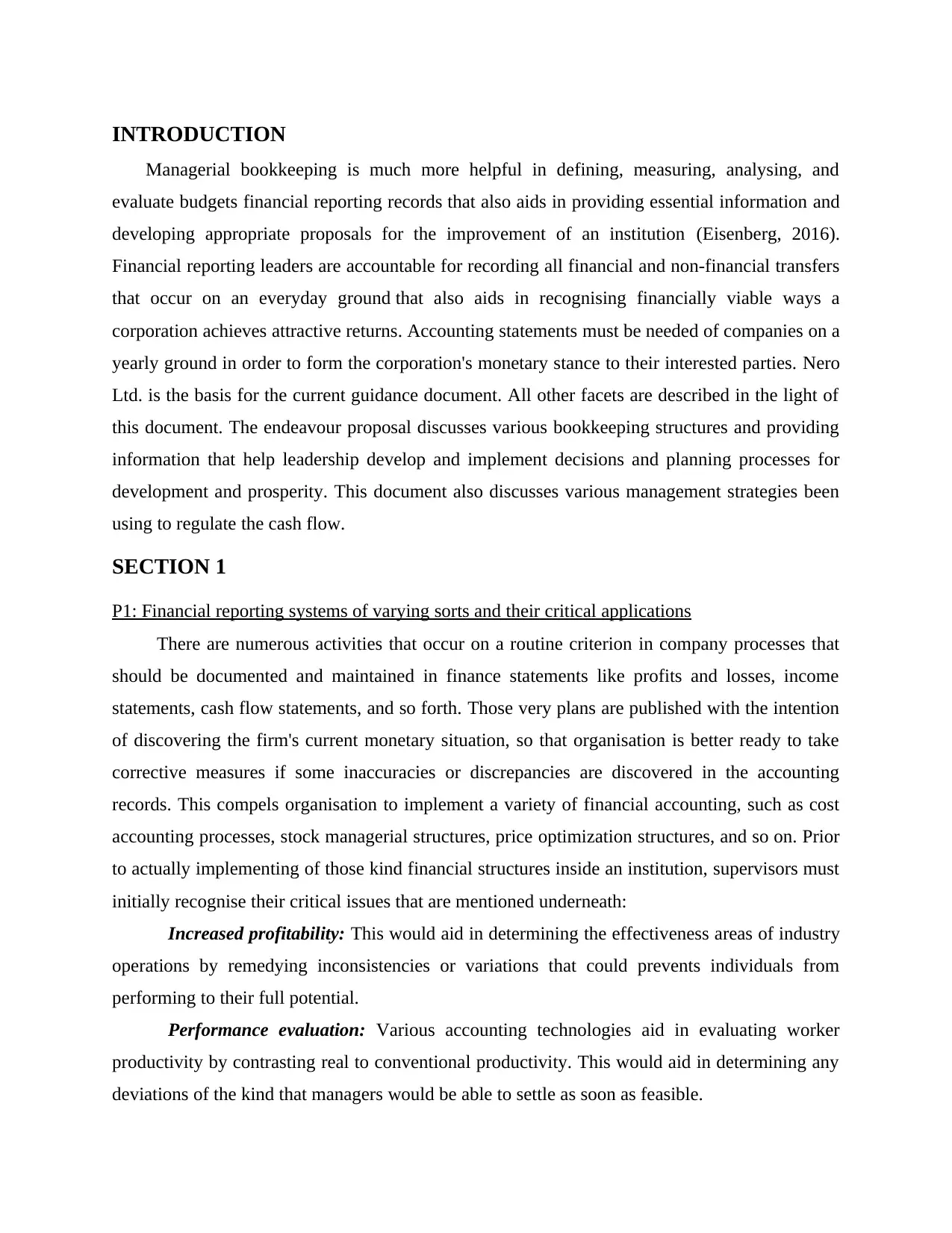
INTRODUCTION
Managerial bookkeeping is much more helpful in defining, measuring, analysing, and
evaluate budgets financial reporting records that also aids in providing essential information and
developing appropriate proposals for the improvement of an institution (Eisenberg, 2016).
Financial reporting leaders are accountable for recording all financial and non-financial transfers
that occur on an everyday ground that also aids in recognising financially viable ways a
corporation achieves attractive returns. Accounting statements must be needed of companies on a
yearly ground in order to form the corporation's monetary stance to their interested parties. Nero
Ltd. is the basis for the current guidance document. All other facets are described in the light of
this document. The endeavour proposal discusses various bookkeeping structures and providing
information that help leadership develop and implement decisions and planning processes for
development and prosperity. This document also discusses various management strategies been
using to regulate the cash flow.
SECTION 1
P1: Financial reporting systems of varying sorts and their critical applications
There are numerous activities that occur on a routine criterion in company processes that
should be documented and maintained in finance statements like profits and losses, income
statements, cash flow statements, and so forth. Those very plans are published with the intention
of discovering the firm's current monetary situation, so that organisation is better ready to take
corrective measures if some inaccuracies or discrepancies are discovered in the accounting
records. This compels organisation to implement a variety of financial accounting, such as cost
accounting processes, stock managerial structures, price optimization structures, and so on. Prior
to actually implementing of those kind financial structures inside an institution, supervisors must
initially recognise their critical issues that are mentioned underneath:
Increased profitability: This would aid in determining the effectiveness areas of industry
operations by remedying inconsistencies or variations that could prevents individuals from
performing to their full potential.
Performance evaluation: Various accounting technologies aid in evaluating worker
productivity by contrasting real to conventional productivity. This would aid in determining any
deviations of the kind that managers would be able to settle as soon as feasible.
Managerial bookkeeping is much more helpful in defining, measuring, analysing, and
evaluate budgets financial reporting records that also aids in providing essential information and
developing appropriate proposals for the improvement of an institution (Eisenberg, 2016).
Financial reporting leaders are accountable for recording all financial and non-financial transfers
that occur on an everyday ground that also aids in recognising financially viable ways a
corporation achieves attractive returns. Accounting statements must be needed of companies on a
yearly ground in order to form the corporation's monetary stance to their interested parties. Nero
Ltd. is the basis for the current guidance document. All other facets are described in the light of
this document. The endeavour proposal discusses various bookkeeping structures and providing
information that help leadership develop and implement decisions and planning processes for
development and prosperity. This document also discusses various management strategies been
using to regulate the cash flow.
SECTION 1
P1: Financial reporting systems of varying sorts and their critical applications
There are numerous activities that occur on a routine criterion in company processes that
should be documented and maintained in finance statements like profits and losses, income
statements, cash flow statements, and so forth. Those very plans are published with the intention
of discovering the firm's current monetary situation, so that organisation is better ready to take
corrective measures if some inaccuracies or discrepancies are discovered in the accounting
records. This compels organisation to implement a variety of financial accounting, such as cost
accounting processes, stock managerial structures, price optimization structures, and so on. Prior
to actually implementing of those kind financial structures inside an institution, supervisors must
initially recognise their critical issues that are mentioned underneath:
Increased profitability: This would aid in determining the effectiveness areas of industry
operations by remedying inconsistencies or variations that could prevents individuals from
performing to their full potential.
Performance evaluation: Various accounting technologies aid in evaluating worker
productivity by contrasting real to conventional productivity. This would aid in determining any
deviations of the kind that managers would be able to settle as soon as feasible.
Secure Best Marks with AI Grader
Need help grading? Try our AI Grader for instant feedback on your assignments.
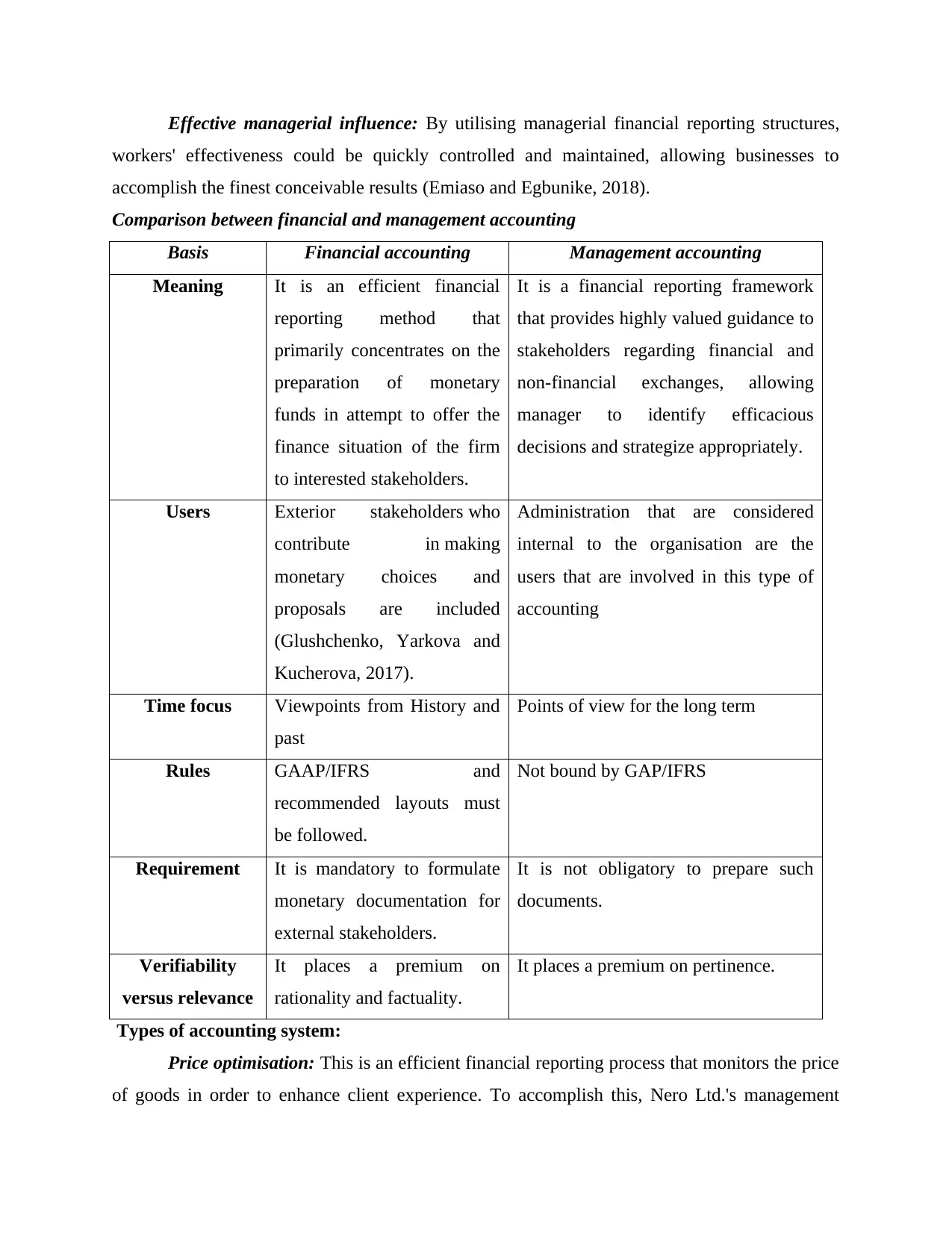
Effective managerial influence: By utilising managerial financial reporting structures,
workers' effectiveness could be quickly controlled and maintained, allowing businesses to
accomplish the finest conceivable results (Emiaso and Egbunike, 2018).
Comparison between financial and management accounting
Basis Financial accounting Management accounting
Meaning It is an efficient financial
reporting method that
primarily concentrates on the
preparation of monetary
funds in attempt to offer the
finance situation of the firm
to interested stakeholders.
It is a financial reporting framework
that provides highly valued guidance to
stakeholders regarding financial and
non-financial exchanges, allowing
manager to identify efficacious
decisions and strategize appropriately.
Users Exterior stakeholders who
contribute in making
monetary choices and
proposals are included
(Glushchenko, Yarkova and
Kucherova, 2017).
Administration that are considered
internal to the organisation are the
users that are involved in this type of
accounting
Time focus Viewpoints from History and
past
Points of view for the long term
Rules GAAP/IFRS and
recommended layouts must
be followed.
Not bound by GAP/IFRS
Requirement It is mandatory to formulate
monetary documentation for
external stakeholders.
It is not obligatory to prepare such
documents.
Verifiability
versus relevance
It places a premium on
rationality and factuality.
It places a premium on pertinence.
Types of accounting system:
Price optimisation: This is an efficient financial reporting process that monitors the price
of goods in order to enhance client experience. To accomplish this, Nero Ltd.'s management
workers' effectiveness could be quickly controlled and maintained, allowing businesses to
accomplish the finest conceivable results (Emiaso and Egbunike, 2018).
Comparison between financial and management accounting
Basis Financial accounting Management accounting
Meaning It is an efficient financial
reporting method that
primarily concentrates on the
preparation of monetary
funds in attempt to offer the
finance situation of the firm
to interested stakeholders.
It is a financial reporting framework
that provides highly valued guidance to
stakeholders regarding financial and
non-financial exchanges, allowing
manager to identify efficacious
decisions and strategize appropriately.
Users Exterior stakeholders who
contribute in making
monetary choices and
proposals are included
(Glushchenko, Yarkova and
Kucherova, 2017).
Administration that are considered
internal to the organisation are the
users that are involved in this type of
accounting
Time focus Viewpoints from History and
past
Points of view for the long term
Rules GAAP/IFRS and
recommended layouts must
be followed.
Not bound by GAP/IFRS
Requirement It is mandatory to formulate
monetary documentation for
external stakeholders.
It is not obligatory to prepare such
documents.
Verifiability
versus relevance
It places a premium on
rationality and factuality.
It places a premium on pertinence.
Types of accounting system:
Price optimisation: This is an efficient financial reporting process that monitors the price
of goods in order to enhance client experience. To accomplish this, Nero Ltd.'s management
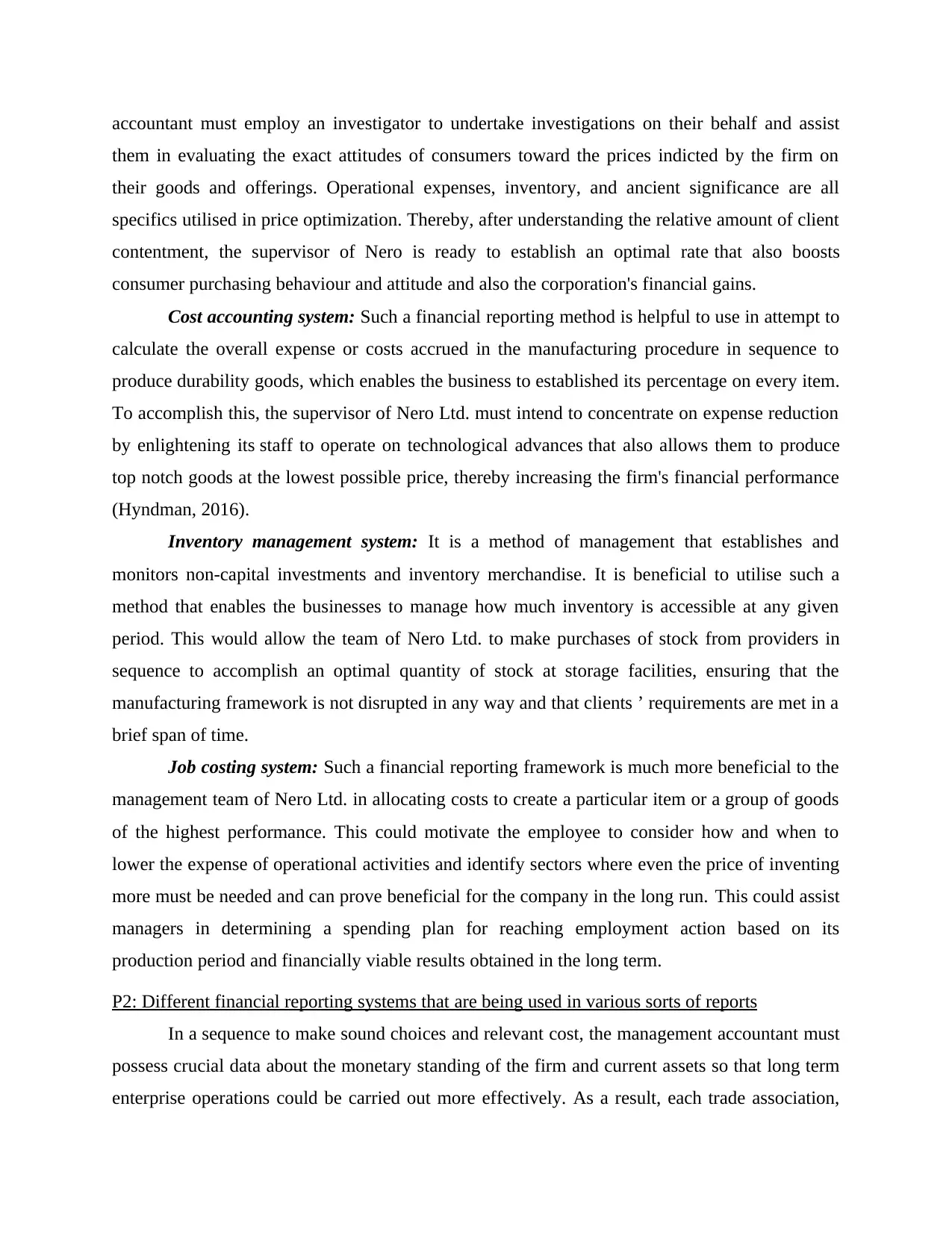
accountant must employ an investigator to undertake investigations on their behalf and assist
them in evaluating the exact attitudes of consumers toward the prices indicted by the firm on
their goods and offerings. Operational expenses, inventory, and ancient significance are all
specifics utilised in price optimization. Thereby, after understanding the relative amount of client
contentment, the supervisor of Nero is ready to establish an optimal rate that also boosts
consumer purchasing behaviour and attitude and also the corporation's financial gains.
Cost accounting system: Such a financial reporting method is helpful to use in attempt to
calculate the overall expense or costs accrued in the manufacturing procedure in sequence to
produce durability goods, which enables the business to established its percentage on every item.
To accomplish this, the supervisor of Nero Ltd. must intend to concentrate on expense reduction
by enlightening its staff to operate on technological advances that also allows them to produce
top notch goods at the lowest possible price, thereby increasing the firm's financial performance
(Hyndman, 2016).
Inventory management system: It is a method of management that establishes and
monitors non-capital investments and inventory merchandise. It is beneficial to utilise such a
method that enables the businesses to manage how much inventory is accessible at any given
period. This would allow the team of Nero Ltd. to make purchases of stock from providers in
sequence to accomplish an optimal quantity of stock at storage facilities, ensuring that the
manufacturing framework is not disrupted in any way and that clients ’ requirements are met in a
brief span of time.
Job costing system: Such a financial reporting framework is much more beneficial to the
management team of Nero Ltd. in allocating costs to create a particular item or a group of goods
of the highest performance. This could motivate the employee to consider how and when to
lower the expense of operational activities and identify sectors where even the price of inventing
more must be needed and can prove beneficial for the company in the long run. This could assist
managers in determining a spending plan for reaching employment action based on its
production period and financially viable results obtained in the long term.
P2: Different financial reporting systems that are being used in various sorts of reports
In a sequence to make sound choices and relevant cost, the management accountant must
possess crucial data about the monetary standing of the firm and current assets so that long term
enterprise operations could be carried out more effectively. As a result, each trade association,
them in evaluating the exact attitudes of consumers toward the prices indicted by the firm on
their goods and offerings. Operational expenses, inventory, and ancient significance are all
specifics utilised in price optimization. Thereby, after understanding the relative amount of client
contentment, the supervisor of Nero is ready to establish an optimal rate that also boosts
consumer purchasing behaviour and attitude and also the corporation's financial gains.
Cost accounting system: Such a financial reporting method is helpful to use in attempt to
calculate the overall expense or costs accrued in the manufacturing procedure in sequence to
produce durability goods, which enables the business to established its percentage on every item.
To accomplish this, the supervisor of Nero Ltd. must intend to concentrate on expense reduction
by enlightening its staff to operate on technological advances that also allows them to produce
top notch goods at the lowest possible price, thereby increasing the firm's financial performance
(Hyndman, 2016).
Inventory management system: It is a method of management that establishes and
monitors non-capital investments and inventory merchandise. It is beneficial to utilise such a
method that enables the businesses to manage how much inventory is accessible at any given
period. This would allow the team of Nero Ltd. to make purchases of stock from providers in
sequence to accomplish an optimal quantity of stock at storage facilities, ensuring that the
manufacturing framework is not disrupted in any way and that clients ’ requirements are met in a
brief span of time.
Job costing system: Such a financial reporting framework is much more beneficial to the
management team of Nero Ltd. in allocating costs to create a particular item or a group of goods
of the highest performance. This could motivate the employee to consider how and when to
lower the expense of operational activities and identify sectors where even the price of inventing
more must be needed and can prove beneficial for the company in the long run. This could assist
managers in determining a spending plan for reaching employment action based on its
production period and financially viable results obtained in the long term.
P2: Different financial reporting systems that are being used in various sorts of reports
In a sequence to make sound choices and relevant cost, the management accountant must
possess crucial data about the monetary standing of the firm and current assets so that long term
enterprise operations could be carried out more effectively. As a result, each trade association,
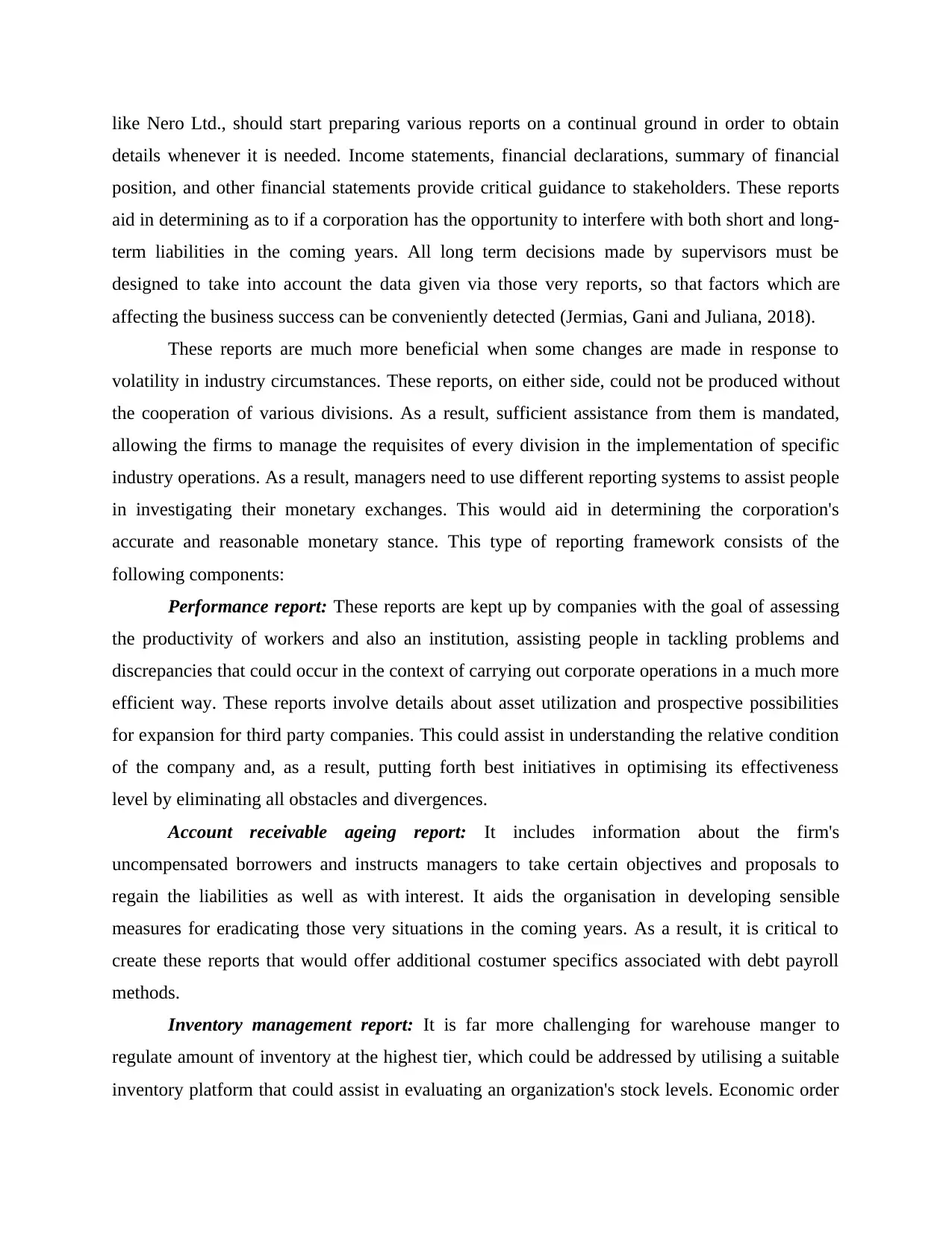
like Nero Ltd., should start preparing various reports on a continual ground in order to obtain
details whenever it is needed. Income statements, financial declarations, summary of financial
position, and other financial statements provide critical guidance to stakeholders. These reports
aid in determining as to if a corporation has the opportunity to interfere with both short and long-
term liabilities in the coming years. All long term decisions made by supervisors must be
designed to take into account the data given via those very reports, so that factors which are
affecting the business success can be conveniently detected (Jermias, Gani and Juliana, 2018).
These reports are much more beneficial when some changes are made in response to
volatility in industry circumstances. These reports, on either side, could not be produced without
the cooperation of various divisions. As a result, sufficient assistance from them is mandated,
allowing the firms to manage the requisites of every division in the implementation of specific
industry operations. As a result, managers need to use different reporting systems to assist people
in investigating their monetary exchanges. This would aid in determining the corporation's
accurate and reasonable monetary stance. This type of reporting framework consists of the
following components:
Performance report: These reports are kept up by companies with the goal of assessing
the productivity of workers and also an institution, assisting people in tackling problems and
discrepancies that could occur in the context of carrying out corporate operations in a much more
efficient way. These reports involve details about asset utilization and prospective possibilities
for expansion for third party companies. This could assist in understanding the relative condition
of the company and, as a result, putting forth best initiatives in optimising its effectiveness
level by eliminating all obstacles and divergences.
Account receivable ageing report: It includes information about the firm's
uncompensated borrowers and instructs managers to take certain objectives and proposals to
regain the liabilities as well as with interest. It aids the organisation in developing sensible
measures for eradicating those very situations in the coming years. As a result, it is critical to
create these reports that would offer additional costumer specifics associated with debt payroll
methods.
Inventory management report: It is far more challenging for warehouse manger to
regulate amount of inventory at the highest tier, which could be addressed by utilising a suitable
inventory platform that could assist in evaluating an organization's stock levels. Economic order
details whenever it is needed. Income statements, financial declarations, summary of financial
position, and other financial statements provide critical guidance to stakeholders. These reports
aid in determining as to if a corporation has the opportunity to interfere with both short and long-
term liabilities in the coming years. All long term decisions made by supervisors must be
designed to take into account the data given via those very reports, so that factors which are
affecting the business success can be conveniently detected (Jermias, Gani and Juliana, 2018).
These reports are much more beneficial when some changes are made in response to
volatility in industry circumstances. These reports, on either side, could not be produced without
the cooperation of various divisions. As a result, sufficient assistance from them is mandated,
allowing the firms to manage the requisites of every division in the implementation of specific
industry operations. As a result, managers need to use different reporting systems to assist people
in investigating their monetary exchanges. This would aid in determining the corporation's
accurate and reasonable monetary stance. This type of reporting framework consists of the
following components:
Performance report: These reports are kept up by companies with the goal of assessing
the productivity of workers and also an institution, assisting people in tackling problems and
discrepancies that could occur in the context of carrying out corporate operations in a much more
efficient way. These reports involve details about asset utilization and prospective possibilities
for expansion for third party companies. This could assist in understanding the relative condition
of the company and, as a result, putting forth best initiatives in optimising its effectiveness
level by eliminating all obstacles and divergences.
Account receivable ageing report: It includes information about the firm's
uncompensated borrowers and instructs managers to take certain objectives and proposals to
regain the liabilities as well as with interest. It aids the organisation in developing sensible
measures for eradicating those very situations in the coming years. As a result, it is critical to
create these reports that would offer additional costumer specifics associated with debt payroll
methods.
Inventory management report: It is far more challenging for warehouse manger to
regulate amount of inventory at the highest tier, which could be addressed by utilising a suitable
inventory platform that could assist in evaluating an organization's stock levels. Economic order
Paraphrase This Document
Need a fresh take? Get an instant paraphrase of this document with our AI Paraphraser
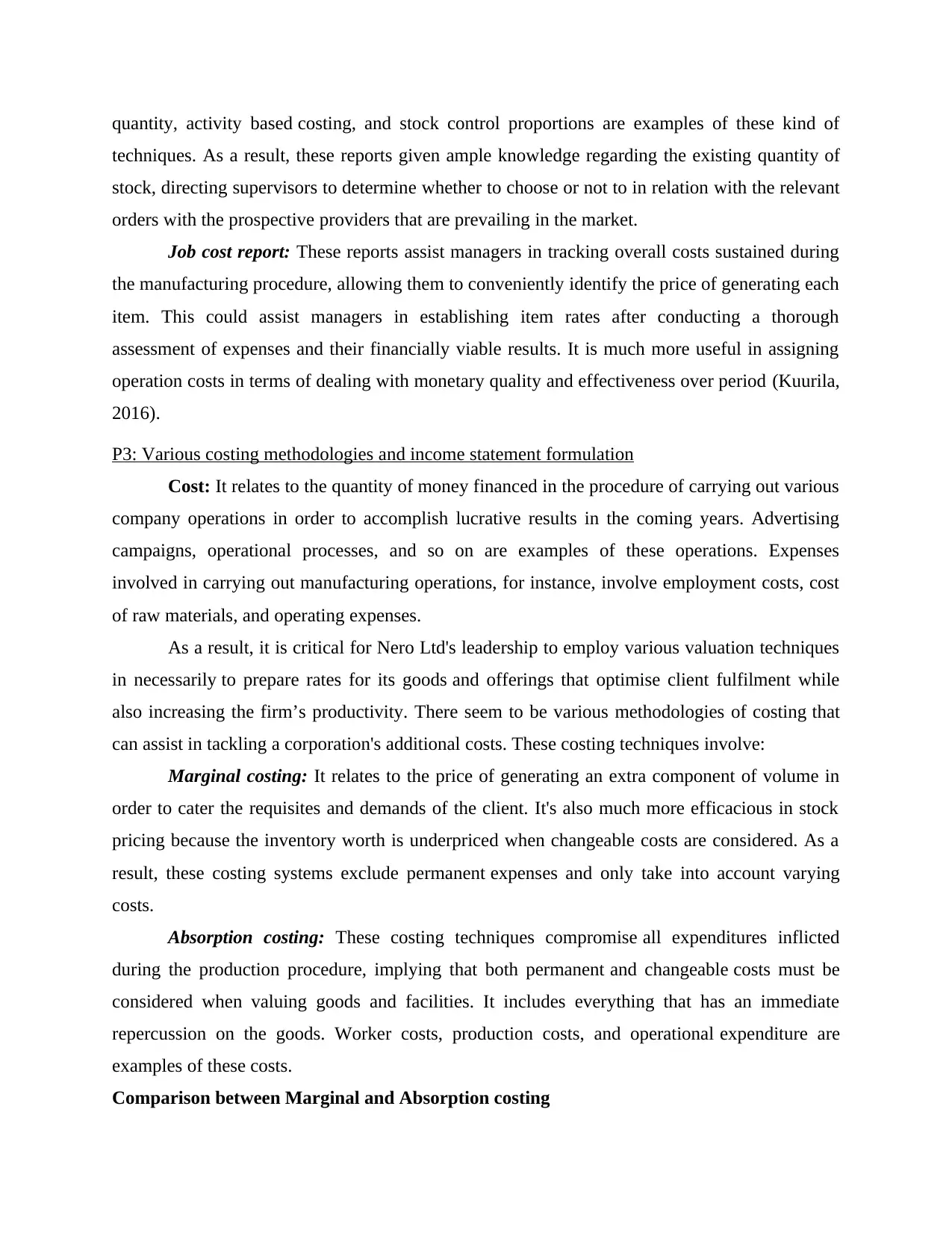
quantity, activity based costing, and stock control proportions are examples of these kind of
techniques. As a result, these reports given ample knowledge regarding the existing quantity of
stock, directing supervisors to determine whether to choose or not to in relation with the relevant
orders with the prospective providers that are prevailing in the market.
Job cost report: These reports assist managers in tracking overall costs sustained during
the manufacturing procedure, allowing them to conveniently identify the price of generating each
item. This could assist managers in establishing item rates after conducting a thorough
assessment of expenses and their financially viable results. It is much more useful in assigning
operation costs in terms of dealing with monetary quality and effectiveness over period (Kuurila,
2016).
P3: Various costing methodologies and income statement formulation
Cost: It relates to the quantity of money financed in the procedure of carrying out various
company operations in order to accomplish lucrative results in the coming years. Advertising
campaigns, operational processes, and so on are examples of these operations. Expenses
involved in carrying out manufacturing operations, for instance, involve employment costs, cost
of raw materials, and operating expenses.
As a result, it is critical for Nero Ltd's leadership to employ various valuation techniques
in necessarily to prepare rates for its goods and offerings that optimise client fulfilment while
also increasing the firm’s productivity. There seem to be various methodologies of costing that
can assist in tackling a corporation's additional costs. These costing techniques involve:
Marginal costing: It relates to the price of generating an extra component of volume in
order to cater the requisites and demands of the client. It's also much more efficacious in stock
pricing because the inventory worth is underpriced when changeable costs are considered. As a
result, these costing systems exclude permanent expenses and only take into account varying
costs.
Absorption costing: These costing techniques compromise all expenditures inflicted
during the production procedure, implying that both permanent and changeable costs must be
considered when valuing goods and facilities. It includes everything that has an immediate
repercussion on the goods. Worker costs, production costs, and operational expenditure are
examples of these costs.
Comparison between Marginal and Absorption costing
techniques. As a result, these reports given ample knowledge regarding the existing quantity of
stock, directing supervisors to determine whether to choose or not to in relation with the relevant
orders with the prospective providers that are prevailing in the market.
Job cost report: These reports assist managers in tracking overall costs sustained during
the manufacturing procedure, allowing them to conveniently identify the price of generating each
item. This could assist managers in establishing item rates after conducting a thorough
assessment of expenses and their financially viable results. It is much more useful in assigning
operation costs in terms of dealing with monetary quality and effectiveness over period (Kuurila,
2016).
P3: Various costing methodologies and income statement formulation
Cost: It relates to the quantity of money financed in the procedure of carrying out various
company operations in order to accomplish lucrative results in the coming years. Advertising
campaigns, operational processes, and so on are examples of these operations. Expenses
involved in carrying out manufacturing operations, for instance, involve employment costs, cost
of raw materials, and operating expenses.
As a result, it is critical for Nero Ltd's leadership to employ various valuation techniques
in necessarily to prepare rates for its goods and offerings that optimise client fulfilment while
also increasing the firm’s productivity. There seem to be various methodologies of costing that
can assist in tackling a corporation's additional costs. These costing techniques involve:
Marginal costing: It relates to the price of generating an extra component of volume in
order to cater the requisites and demands of the client. It's also much more efficacious in stock
pricing because the inventory worth is underpriced when changeable costs are considered. As a
result, these costing systems exclude permanent expenses and only take into account varying
costs.
Absorption costing: These costing techniques compromise all expenditures inflicted
during the production procedure, implying that both permanent and changeable costs must be
considered when valuing goods and facilities. It includes everything that has an immediate
repercussion on the goods. Worker costs, production costs, and operational expenditure are
examples of these costs.
Comparison between Marginal and Absorption costing
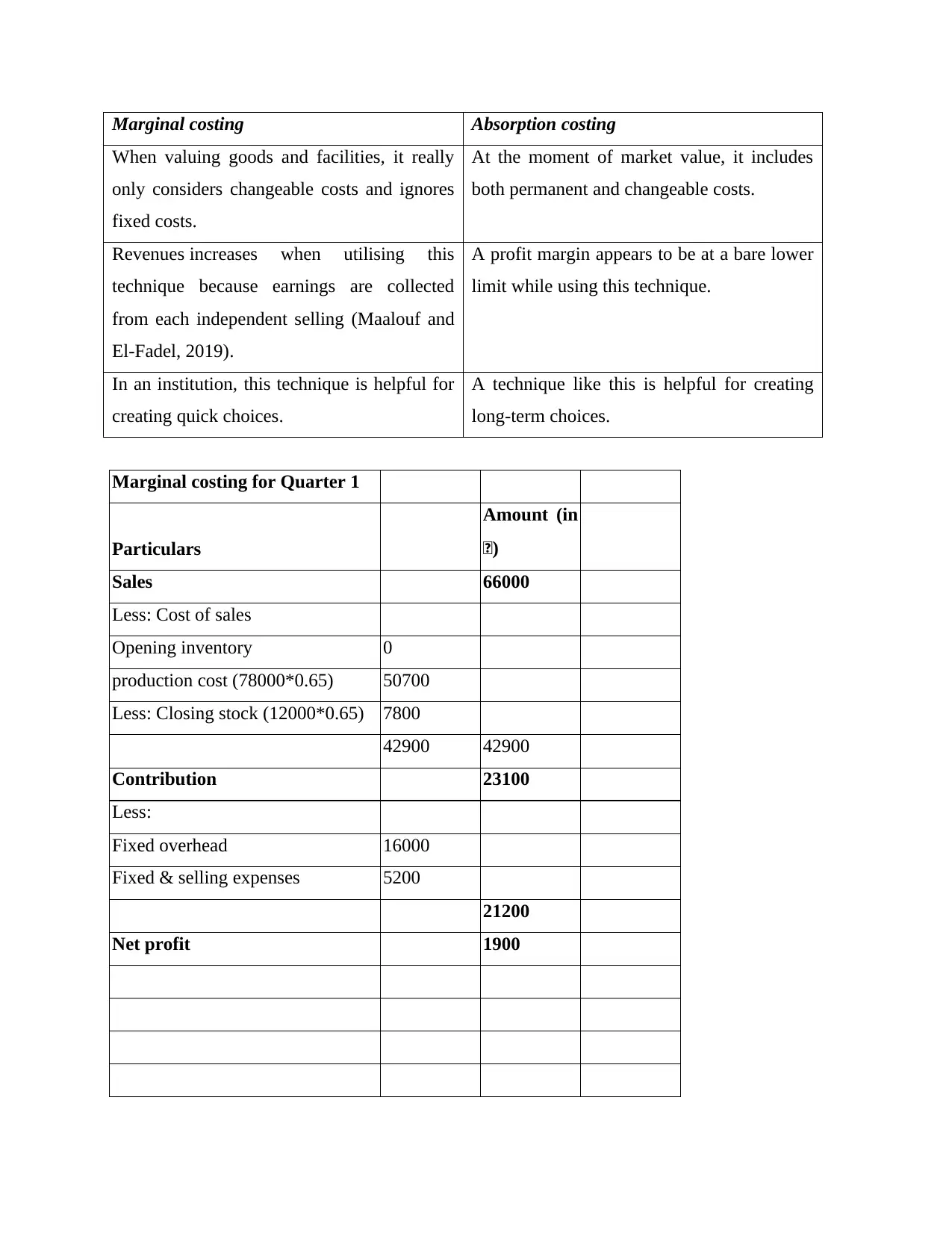
Marginal costing Absorption costing
When valuing goods and facilities, it really
only considers changeable costs and ignores
fixed costs.
At the moment of market value, it includes
both permanent and changeable costs.
Revenues increases when utilising this
technique because earnings are collected
from each independent selling (Maalouf and
El-Fadel, 2019).
A profit margin appears to be at a bare lower
limit while using this technique.
In an institution, this technique is helpful for
creating quick choices.
A technique like this is helpful for creating
long-term choices.
Marginal costing for Quarter 1
Particulars
Amount (in
£)
Sales 66000
Less: Cost of sales
Opening inventory 0
production cost (78000*0.65) 50700
Less: Closing stock (12000*0.65) 7800
42900 42900
Contribution 23100
Less:
Fixed overhead 16000
Fixed & selling expenses 5200
21200
Net profit 1900
When valuing goods and facilities, it really
only considers changeable costs and ignores
fixed costs.
At the moment of market value, it includes
both permanent and changeable costs.
Revenues increases when utilising this
technique because earnings are collected
from each independent selling (Maalouf and
El-Fadel, 2019).
A profit margin appears to be at a bare lower
limit while using this technique.
In an institution, this technique is helpful for
creating quick choices.
A technique like this is helpful for creating
long-term choices.
Marginal costing for Quarter 1
Particulars
Amount (in
£)
Sales 66000
Less: Cost of sales
Opening inventory 0
production cost (78000*0.65) 50700
Less: Closing stock (12000*0.65) 7800
42900 42900
Contribution 23100
Less:
Fixed overhead 16000
Fixed & selling expenses 5200
21200
Net profit 1900
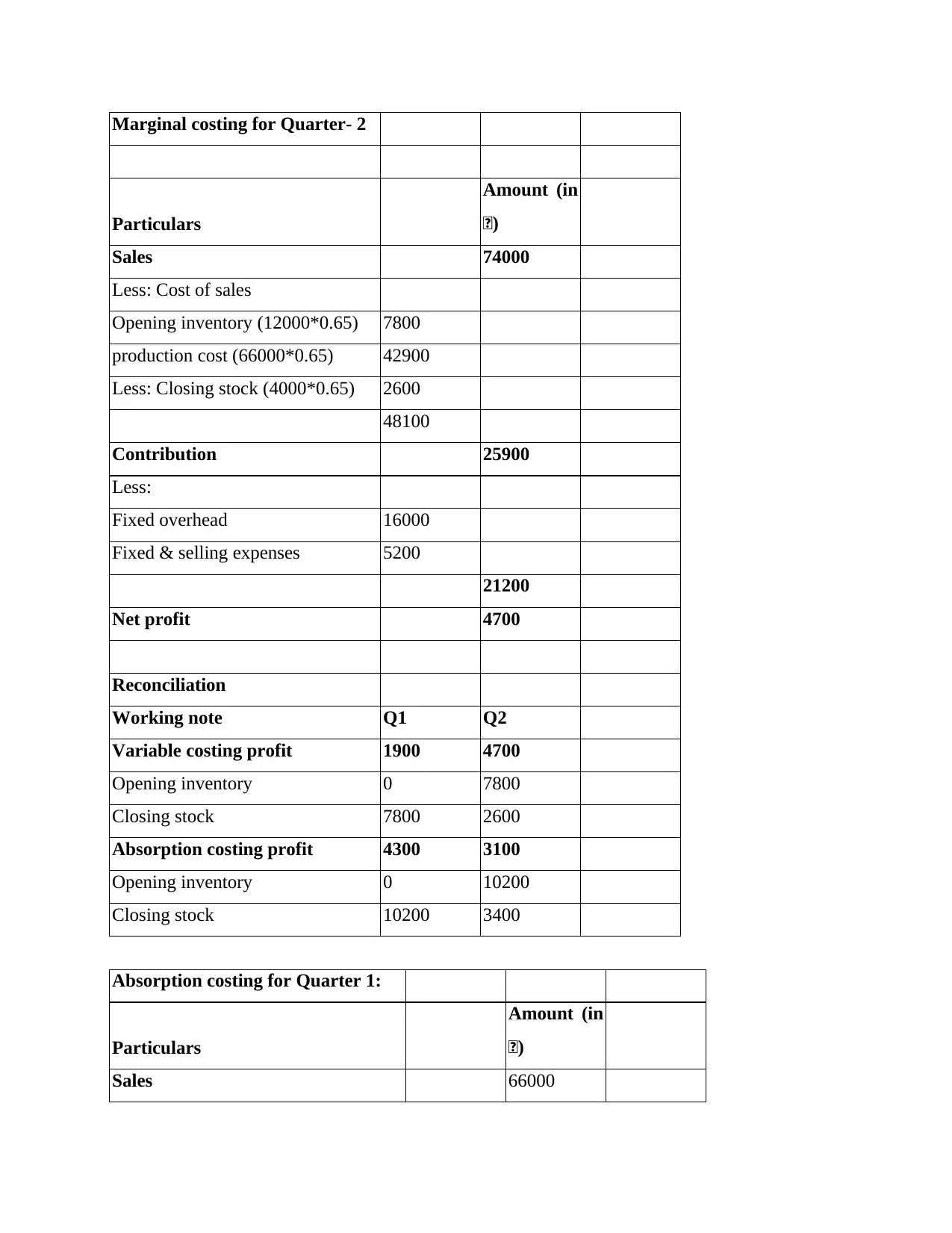
Marginal costing for Quarter- 2
Particulars
Amount (in
£)
Sales 74000
Less: Cost of sales
Opening inventory (12000*0.65) 7800
production cost (66000*0.65) 42900
Less: Closing stock (4000*0.65) 2600
48100
Contribution 25900
Less:
Fixed overhead 16000
Fixed & selling expenses 5200
21200
Net profit 4700
Reconciliation
Working note Q1 Q2
Variable costing profit 1900 4700
Opening inventory 0 7800
Closing stock 7800 2600
Absorption costing profit 4300 3100
Opening inventory 0 10200
Closing stock 10200 3400
Absorption costing for Quarter 1:
Particulars
Amount (in
£)
Sales 66000
Particulars
Amount (in
£)
Sales 74000
Less: Cost of sales
Opening inventory (12000*0.65) 7800
production cost (66000*0.65) 42900
Less: Closing stock (4000*0.65) 2600
48100
Contribution 25900
Less:
Fixed overhead 16000
Fixed & selling expenses 5200
21200
Net profit 4700
Reconciliation
Working note Q1 Q2
Variable costing profit 1900 4700
Opening inventory 0 7800
Closing stock 7800 2600
Absorption costing profit 4300 3100
Opening inventory 0 10200
Closing stock 10200 3400
Absorption costing for Quarter 1:
Particulars
Amount (in
£)
Sales 66000
Secure Best Marks with AI Grader
Need help grading? Try our AI Grader for instant feedback on your assignments.
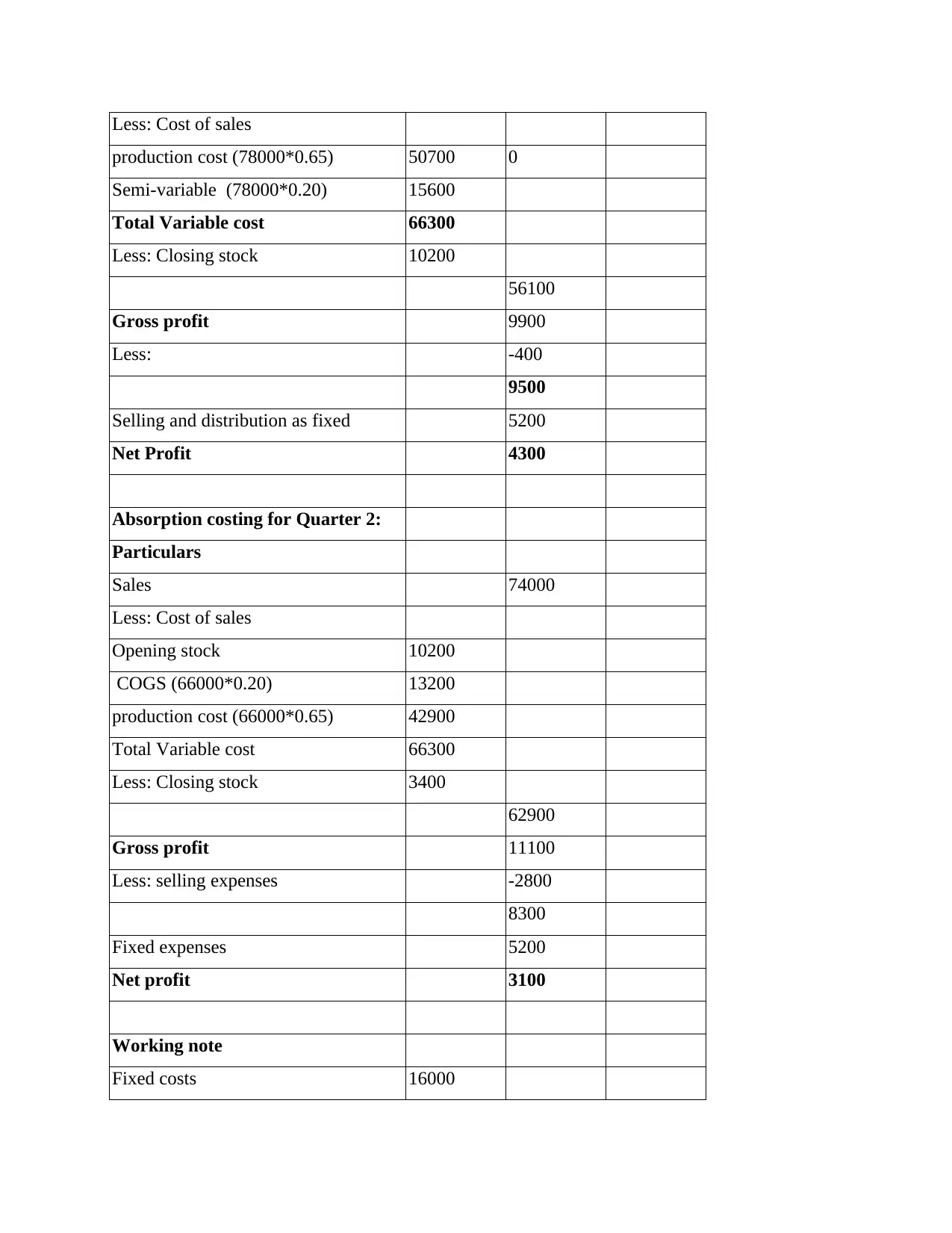
Less: Cost of sales
production cost (78000*0.65) 50700 0
Semi-variable (78000*0.20) 15600
Total Variable cost 66300
Less: Closing stock 10200
56100
Gross profit 9900
Less: -400
9500
Selling and distribution as fixed 5200
Net Profit 4300
Absorption costing for Quarter 2:
Particulars
Sales 74000
Less: Cost of sales
Opening stock 10200
COGS (66000*0.20) 13200
production cost (66000*0.65) 42900
Total Variable cost 66300
Less: Closing stock 3400
62900
Gross profit 11100
Less: selling expenses -2800
8300
Fixed expenses 5200
Net profit 3100
Working note
Fixed costs 16000
production cost (78000*0.65) 50700 0
Semi-variable (78000*0.20) 15600
Total Variable cost 66300
Less: Closing stock 10200
56100
Gross profit 9900
Less: -400
9500
Selling and distribution as fixed 5200
Net Profit 4300
Absorption costing for Quarter 2:
Particulars
Sales 74000
Less: Cost of sales
Opening stock 10200
COGS (66000*0.20) 13200
production cost (66000*0.65) 42900
Total Variable cost 66300
Less: Closing stock 3400
62900
Gross profit 11100
Less: selling expenses -2800
8300
Fixed expenses 5200
Net profit 3100
Working note
Fixed costs 16000
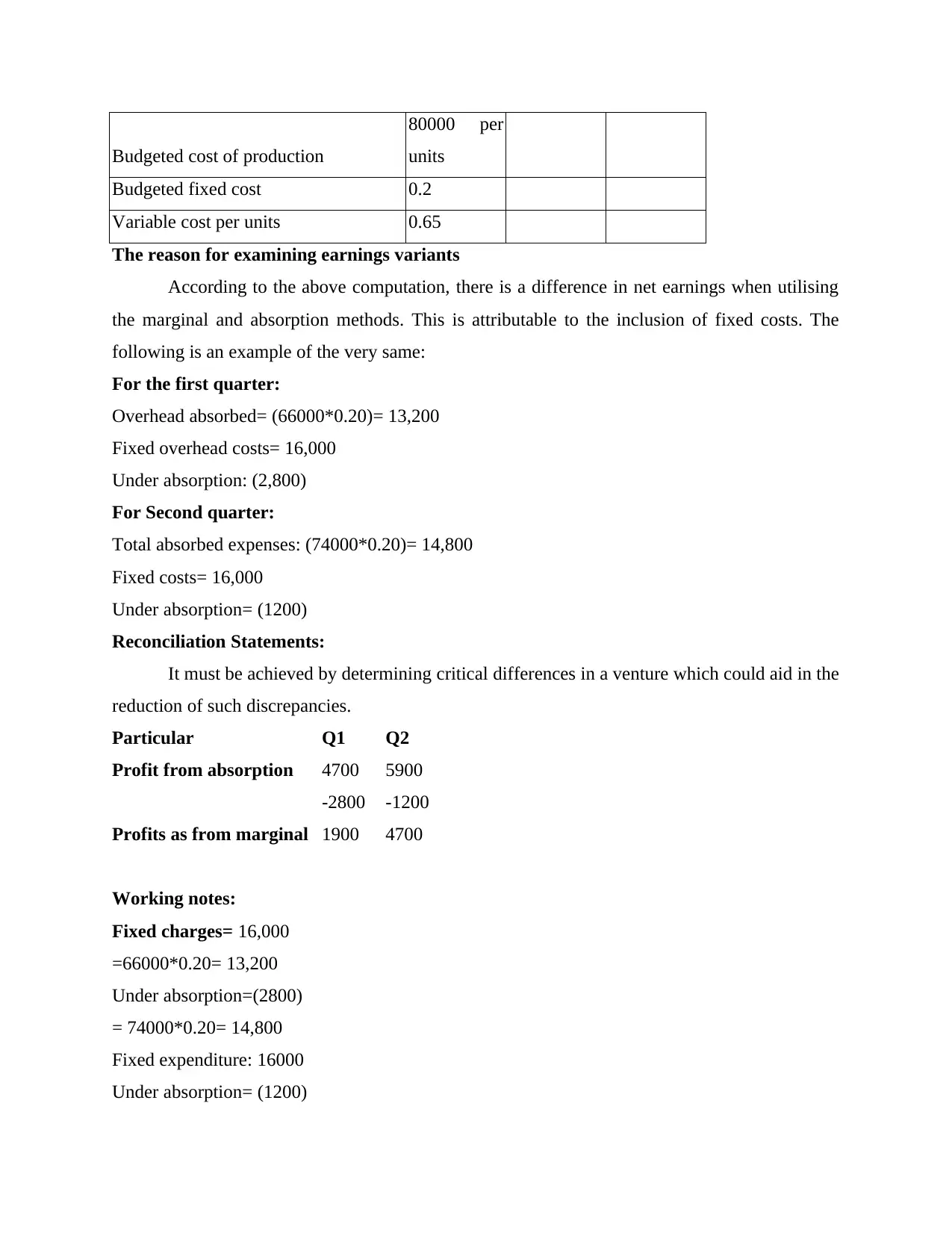
Budgeted cost of production
80000 per
units
Budgeted fixed cost 0.2
Variable cost per units 0.65
The reason for examining earnings variants
According to the above computation, there is a difference in net earnings when utilising
the marginal and absorption methods. This is attributable to the inclusion of fixed costs. The
following is an example of the very same:
For the first quarter:
Overhead absorbed= (66000*0.20)= 13,200
Fixed overhead costs= 16,000
Under absorption: (2,800)
For Second quarter:
Total absorbed expenses: (74000*0.20)= 14,800
Fixed costs= 16,000
Under absorption= (1200)
Reconciliation Statements:
It must be achieved by determining critical differences in a venture which could aid in the
reduction of such discrepancies.
Particular Q1 Q2
Profit from absorption 4700 5900
-2800 -1200
Profits as from marginal 1900 4700
Working notes:
Fixed charges= 16,000
=66000*0.20= 13,200
Under absorption=(2800)
= 74000*0.20= 14,800
Fixed expenditure: 16000
Under absorption= (1200)
80000 per
units
Budgeted fixed cost 0.2
Variable cost per units 0.65
The reason for examining earnings variants
According to the above computation, there is a difference in net earnings when utilising
the marginal and absorption methods. This is attributable to the inclusion of fixed costs. The
following is an example of the very same:
For the first quarter:
Overhead absorbed= (66000*0.20)= 13,200
Fixed overhead costs= 16,000
Under absorption: (2,800)
For Second quarter:
Total absorbed expenses: (74000*0.20)= 14,800
Fixed costs= 16,000
Under absorption= (1200)
Reconciliation Statements:
It must be achieved by determining critical differences in a venture which could aid in the
reduction of such discrepancies.
Particular Q1 Q2
Profit from absorption 4700 5900
-2800 -1200
Profits as from marginal 1900 4700
Working notes:
Fixed charges= 16,000
=66000*0.20= 13,200
Under absorption=(2800)
= 74000*0.20= 14,800
Fixed expenditure: 16000
Under absorption= (1200)
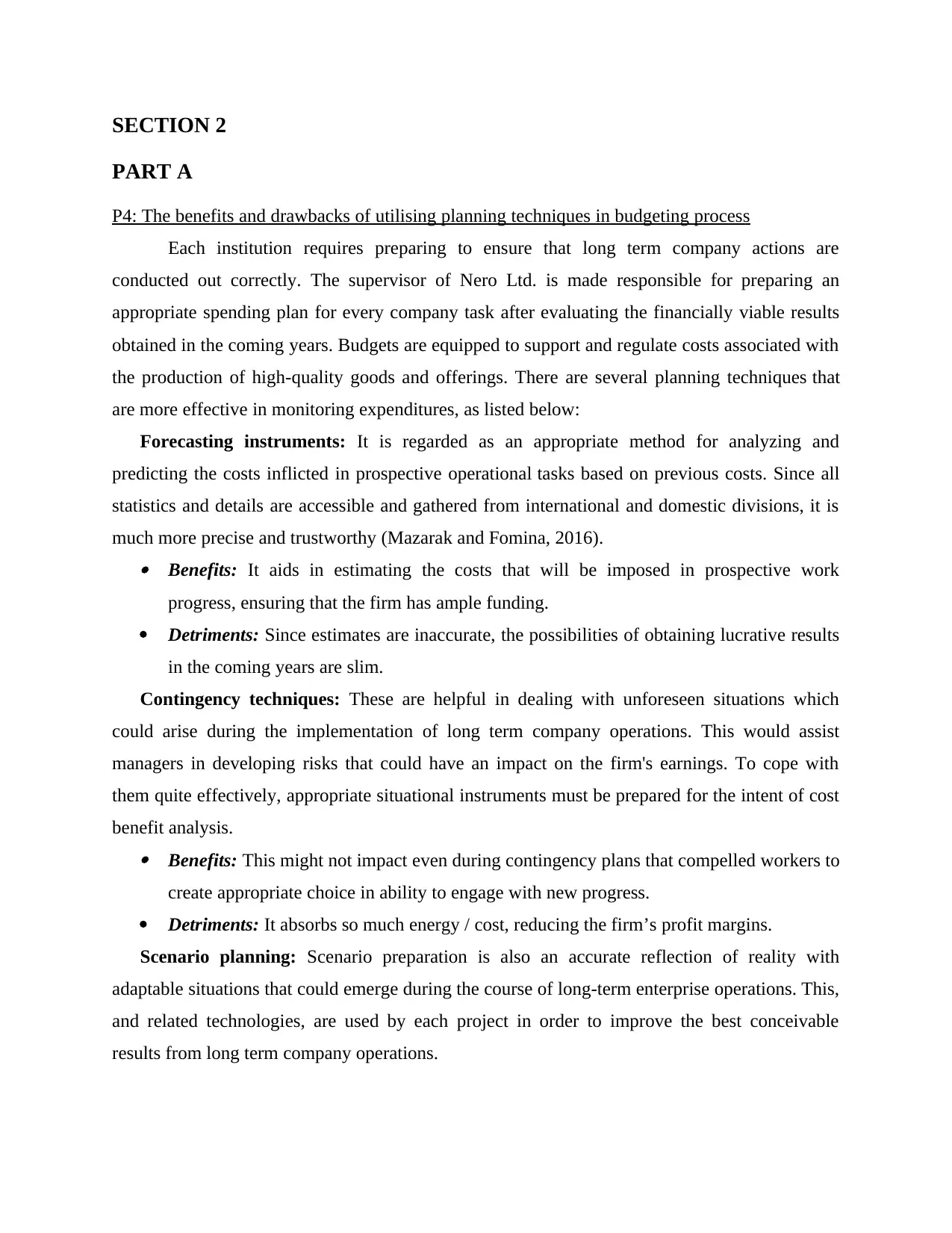
SECTION 2
PART A
P4: The benefits and drawbacks of utilising planning techniques in budgeting process
Each institution requires preparing to ensure that long term company actions are
conducted out correctly. The supervisor of Nero Ltd. is made responsible for preparing an
appropriate spending plan for every company task after evaluating the financially viable results
obtained in the coming years. Budgets are equipped to support and regulate costs associated with
the production of high-quality goods and offerings. There are several planning techniques that
are more effective in monitoring expenditures, as listed below:
Forecasting instruments: It is regarded as an appropriate method for analyzing and
predicting the costs inflicted in prospective operational tasks based on previous costs. Since all
statistics and details are accessible and gathered from international and domestic divisions, it is
much more precise and trustworthy (Mazarak and Fomina, 2016). Benefits: It aids in estimating the costs that will be imposed in prospective work
progress, ensuring that the firm has ample funding.
Detriments: Since estimates are inaccurate, the possibilities of obtaining lucrative results
in the coming years are slim.
Contingency techniques: These are helpful in dealing with unforeseen situations which
could arise during the implementation of long term company operations. This would assist
managers in developing risks that could have an impact on the firm's earnings. To cope with
them quite effectively, appropriate situational instruments must be prepared for the intent of cost
benefit analysis. Benefits: This might not impact even during contingency plans that compelled workers to
create appropriate choice in ability to engage with new progress.
Detriments: It absorbs so much energy / cost, reducing the firm’s profit margins.
Scenario planning: Scenario preparation is also an accurate reflection of reality with
adaptable situations that could emerge during the course of long-term enterprise operations. This,
and related technologies, are used by each project in order to improve the best conceivable
results from long term company operations.
PART A
P4: The benefits and drawbacks of utilising planning techniques in budgeting process
Each institution requires preparing to ensure that long term company actions are
conducted out correctly. The supervisor of Nero Ltd. is made responsible for preparing an
appropriate spending plan for every company task after evaluating the financially viable results
obtained in the coming years. Budgets are equipped to support and regulate costs associated with
the production of high-quality goods and offerings. There are several planning techniques that
are more effective in monitoring expenditures, as listed below:
Forecasting instruments: It is regarded as an appropriate method for analyzing and
predicting the costs inflicted in prospective operational tasks based on previous costs. Since all
statistics and details are accessible and gathered from international and domestic divisions, it is
much more precise and trustworthy (Mazarak and Fomina, 2016). Benefits: It aids in estimating the costs that will be imposed in prospective work
progress, ensuring that the firm has ample funding.
Detriments: Since estimates are inaccurate, the possibilities of obtaining lucrative results
in the coming years are slim.
Contingency techniques: These are helpful in dealing with unforeseen situations which
could arise during the implementation of long term company operations. This would assist
managers in developing risks that could have an impact on the firm's earnings. To cope with
them quite effectively, appropriate situational instruments must be prepared for the intent of cost
benefit analysis. Benefits: This might not impact even during contingency plans that compelled workers to
create appropriate choice in ability to engage with new progress.
Detriments: It absorbs so much energy / cost, reducing the firm’s profit margins.
Scenario planning: Scenario preparation is also an accurate reflection of reality with
adaptable situations that could emerge during the course of long-term enterprise operations. This,
and related technologies, are used by each project in order to improve the best conceivable
results from long term company operations.
Paraphrase This Document
Need a fresh take? Get an instant paraphrase of this document with our AI Paraphraser
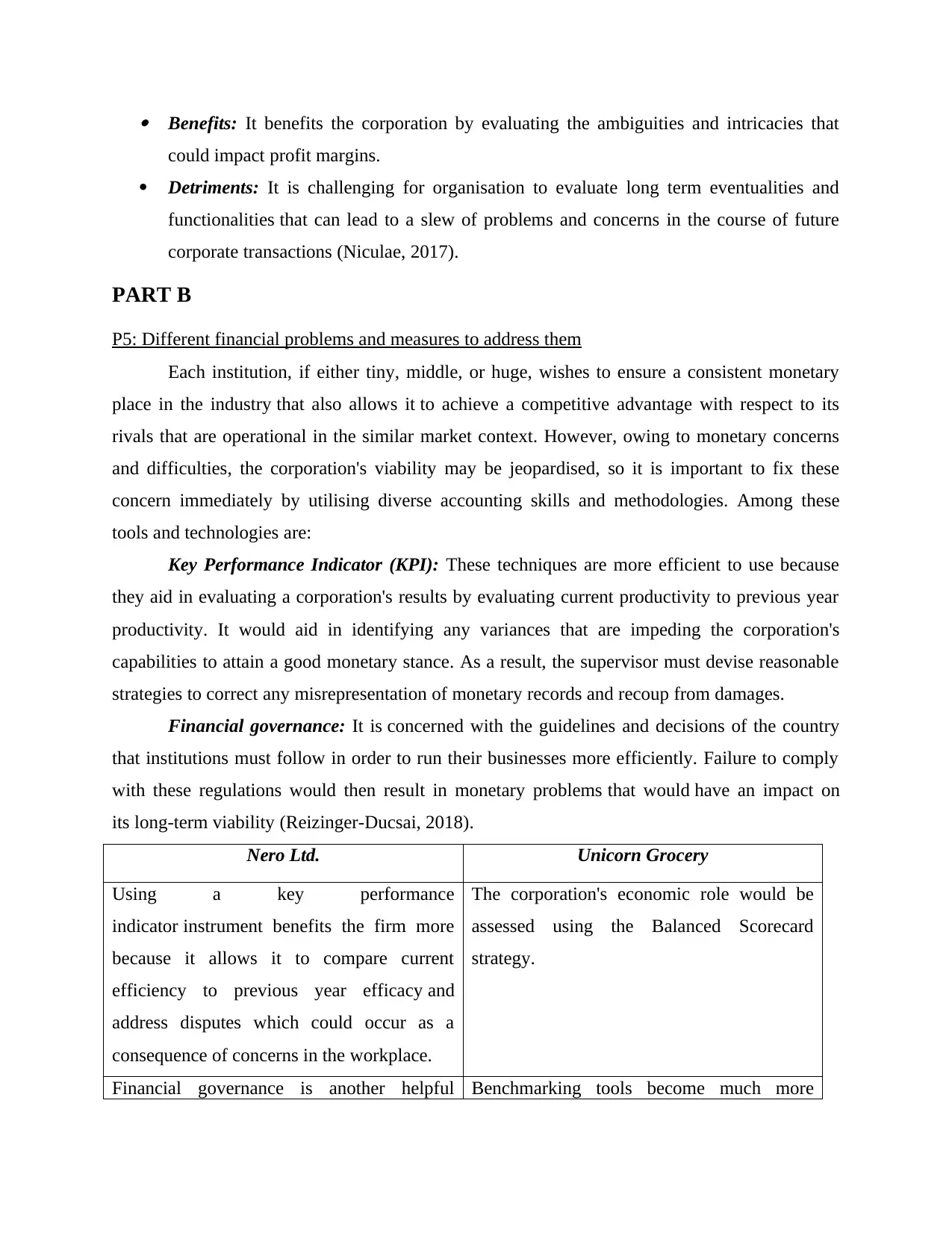
Benefits: It benefits the corporation by evaluating the ambiguities and intricacies that
could impact profit margins.
Detriments: It is challenging for organisation to evaluate long term eventualities and
functionalities that can lead to a slew of problems and concerns in the course of future
corporate transactions (Niculae, 2017).
PART B
P5: Different financial problems and measures to address them
Each institution, if either tiny, middle, or huge, wishes to ensure a consistent monetary
place in the industry that also allows it to achieve a competitive advantage with respect to its
rivals that are operational in the similar market context. However, owing to monetary concerns
and difficulties, the corporation's viability may be jeopardised, so it is important to fix these
concern immediately by utilising diverse accounting skills and methodologies. Among these
tools and technologies are:
Key Performance Indicator (KPI): These techniques are more efficient to use because
they aid in evaluating a corporation's results by evaluating current productivity to previous year
productivity. It would aid in identifying any variances that are impeding the corporation's
capabilities to attain a good monetary stance. As a result, the supervisor must devise reasonable
strategies to correct any misrepresentation of monetary records and recoup from damages.
Financial governance: It is concerned with the guidelines and decisions of the country
that institutions must follow in order to run their businesses more efficiently. Failure to comply
with these regulations would then result in monetary problems that would have an impact on
its long-term viability (Reizinger-Ducsai, 2018).
Nero Ltd. Unicorn Grocery
Using a key performance
indicator instrument benefits the firm more
because it allows it to compare current
efficiency to previous year efficacy and
address disputes which could occur as a
consequence of concerns in the workplace.
The corporation's economic role would be
assessed using the Balanced Scorecard
strategy.
Financial governance is another helpful Benchmarking tools become much more
could impact profit margins.
Detriments: It is challenging for organisation to evaluate long term eventualities and
functionalities that can lead to a slew of problems and concerns in the course of future
corporate transactions (Niculae, 2017).
PART B
P5: Different financial problems and measures to address them
Each institution, if either tiny, middle, or huge, wishes to ensure a consistent monetary
place in the industry that also allows it to achieve a competitive advantage with respect to its
rivals that are operational in the similar market context. However, owing to monetary concerns
and difficulties, the corporation's viability may be jeopardised, so it is important to fix these
concern immediately by utilising diverse accounting skills and methodologies. Among these
tools and technologies are:
Key Performance Indicator (KPI): These techniques are more efficient to use because
they aid in evaluating a corporation's results by evaluating current productivity to previous year
productivity. It would aid in identifying any variances that are impeding the corporation's
capabilities to attain a good monetary stance. As a result, the supervisor must devise reasonable
strategies to correct any misrepresentation of monetary records and recoup from damages.
Financial governance: It is concerned with the guidelines and decisions of the country
that institutions must follow in order to run their businesses more efficiently. Failure to comply
with these regulations would then result in monetary problems that would have an impact on
its long-term viability (Reizinger-Ducsai, 2018).
Nero Ltd. Unicorn Grocery
Using a key performance
indicator instrument benefits the firm more
because it allows it to compare current
efficiency to previous year efficacy and
address disputes which could occur as a
consequence of concerns in the workplace.
The corporation's economic role would be
assessed using the Balanced Scorecard
strategy.
Financial governance is another helpful Benchmarking tools become much more
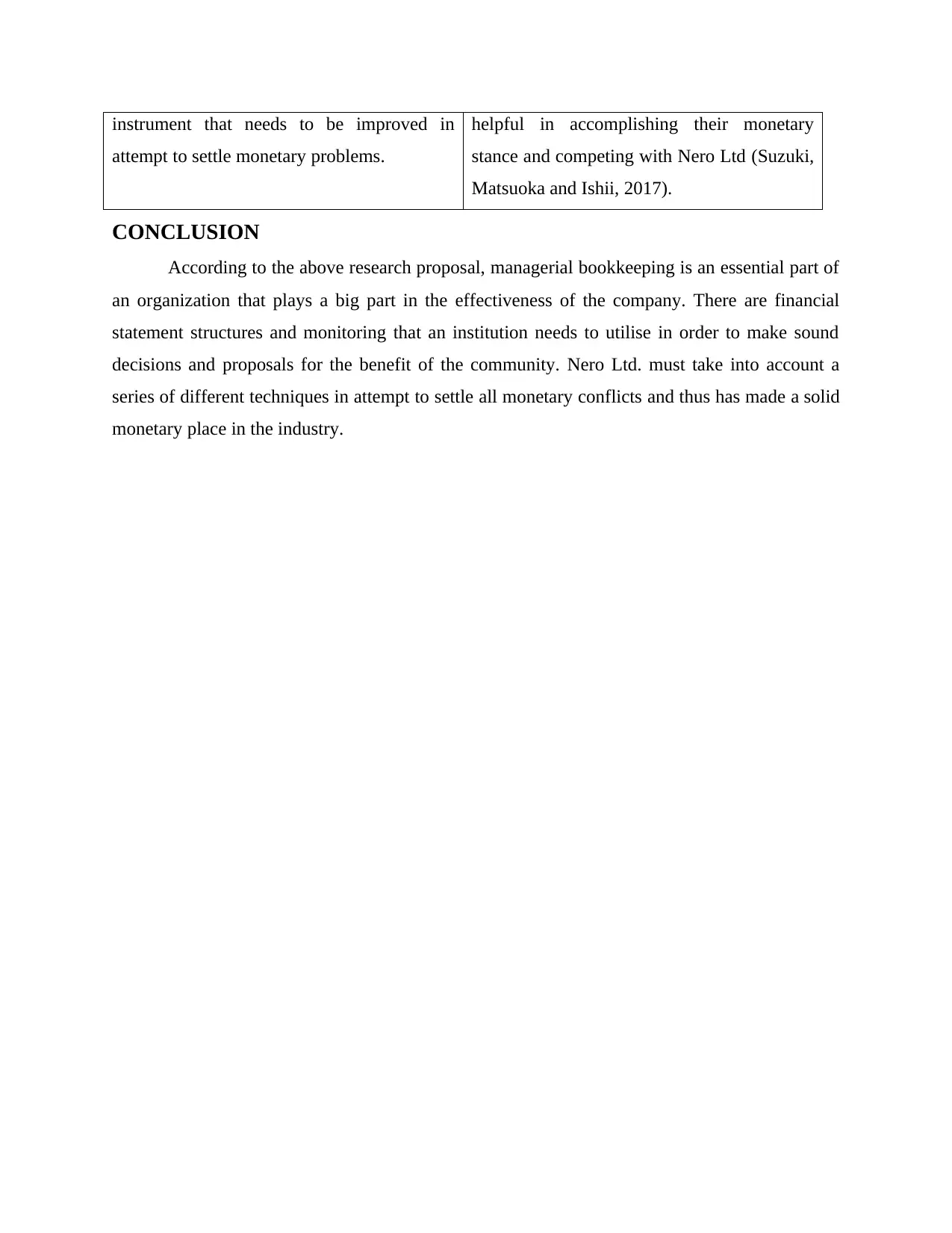
instrument that needs to be improved in
attempt to settle monetary problems.
helpful in accomplishing their monetary
stance and competing with Nero Ltd (Suzuki,
Matsuoka and Ishii, 2017).
CONCLUSION
According to the above research proposal, managerial bookkeeping is an essential part of
an organization that plays a big part in the effectiveness of the company. There are financial
statement structures and monitoring that an institution needs to utilise in order to make sound
decisions and proposals for the benefit of the community. Nero Ltd. must take into account a
series of different techniques in attempt to settle all monetary conflicts and thus has made a solid
monetary place in the industry.
attempt to settle monetary problems.
helpful in accomplishing their monetary
stance and competing with Nero Ltd (Suzuki,
Matsuoka and Ishii, 2017).
CONCLUSION
According to the above research proposal, managerial bookkeeping is an essential part of
an organization that plays a big part in the effectiveness of the company. There are financial
statement structures and monitoring that an institution needs to utilise in order to make sound
decisions and proposals for the benefit of the community. Nero Ltd. must take into account a
series of different techniques in attempt to settle all monetary conflicts and thus has made a solid
monetary place in the industry.
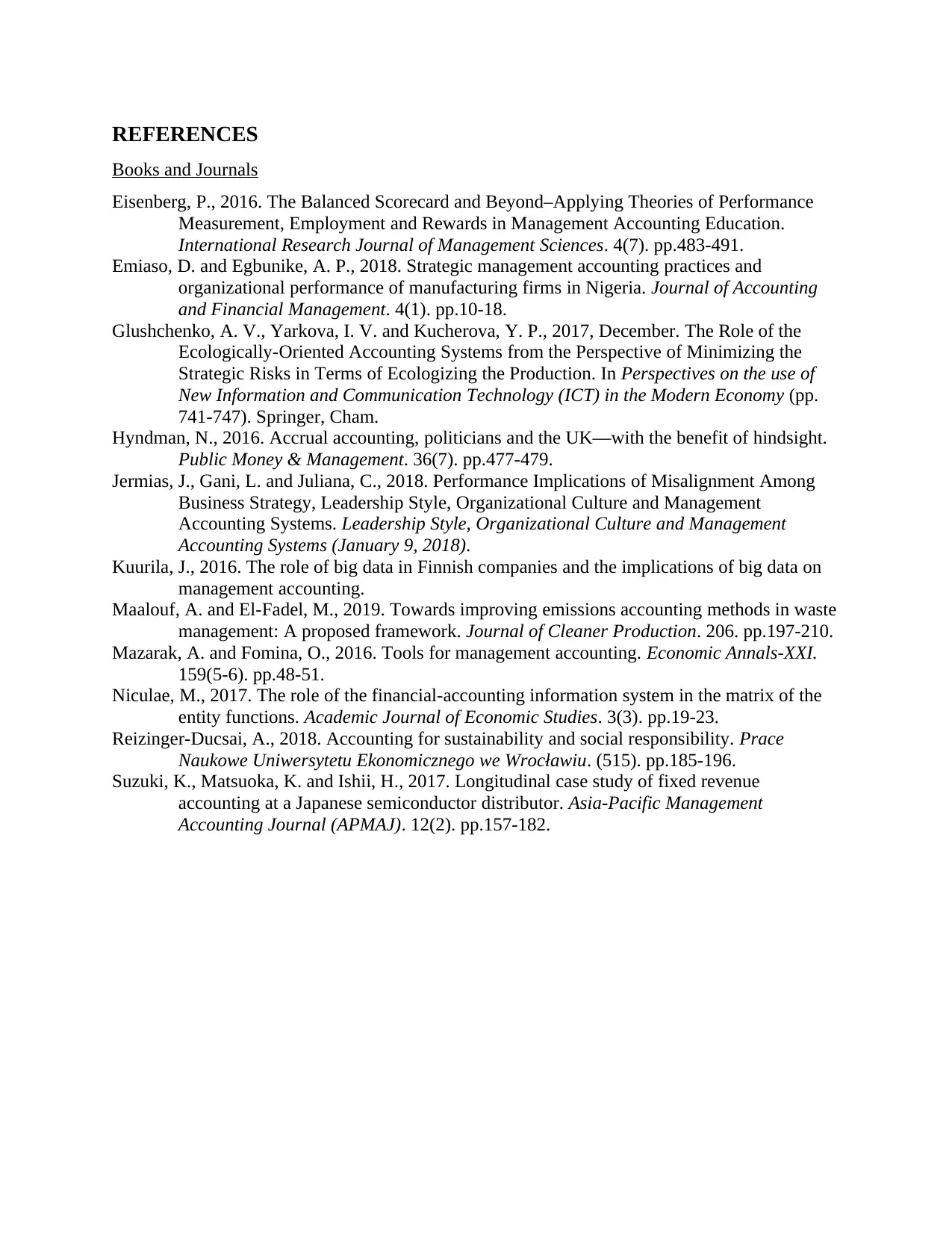
REFERENCES
Books and Journals
Eisenberg, P., 2016. The Balanced Scorecard and Beyond–Applying Theories of Performance
Measurement, Employment and Rewards in Management Accounting Education.
International Research Journal of Management Sciences. 4(7). pp.483-491.
Emiaso, D. and Egbunike, A. P., 2018. Strategic management accounting practices and
organizational performance of manufacturing firms in Nigeria. Journal of Accounting
and Financial Management. 4(1). pp.10-18.
Glushchenko, A. V., Yarkova, I. V. and Kucherova, Y. P., 2017, December. The Role of the
Ecologically-Oriented Accounting Systems from the Perspective of Minimizing the
Strategic Risks in Terms of Ecologizing the Production. In Perspectives on the use of
New Information and Communication Technology (ICT) in the Modern Economy (pp.
741-747). Springer, Cham.
Hyndman, N., 2016. Accrual accounting, politicians and the UK—with the benefit of hindsight.
Public Money & Management. 36(7). pp.477-479.
Jermias, J., Gani, L. and Juliana, C., 2018. Performance Implications of Misalignment Among
Business Strategy, Leadership Style, Organizational Culture and Management
Accounting Systems. Leadership Style, Organizational Culture and Management
Accounting Systems (January 9, 2018).
Kuurila, J., 2016. The role of big data in Finnish companies and the implications of big data on
management accounting.
Maalouf, A. and El-Fadel, M., 2019. Towards improving emissions accounting methods in waste
management: A proposed framework. Journal of Cleaner Production. 206. pp.197-210.
Mazarak, A. and Fomina, O., 2016. Tools for management accounting. Economic Annals-XXI.
159(5-6). pp.48-51.
Niculae, M., 2017. The role of the financial-accounting information system in the matrix of the
entity functions. Academic Journal of Economic Studies. 3(3). pp.19-23.
Reizinger-Ducsai, A., 2018. Accounting for sustainability and social responsibility. Prace
Naukowe Uniwersytetu Ekonomicznego we Wrocławiu. (515). pp.185-196.
Suzuki, K., Matsuoka, K. and Ishii, H., 2017. Longitudinal case study of fixed revenue
accounting at a Japanese semiconductor distributor. Asia-Pacific Management
Accounting Journal (APMAJ). 12(2). pp.157-182.
Books and Journals
Eisenberg, P., 2016. The Balanced Scorecard and Beyond–Applying Theories of Performance
Measurement, Employment and Rewards in Management Accounting Education.
International Research Journal of Management Sciences. 4(7). pp.483-491.
Emiaso, D. and Egbunike, A. P., 2018. Strategic management accounting practices and
organizational performance of manufacturing firms in Nigeria. Journal of Accounting
and Financial Management. 4(1). pp.10-18.
Glushchenko, A. V., Yarkova, I. V. and Kucherova, Y. P., 2017, December. The Role of the
Ecologically-Oriented Accounting Systems from the Perspective of Minimizing the
Strategic Risks in Terms of Ecologizing the Production. In Perspectives on the use of
New Information and Communication Technology (ICT) in the Modern Economy (pp.
741-747). Springer, Cham.
Hyndman, N., 2016. Accrual accounting, politicians and the UK—with the benefit of hindsight.
Public Money & Management. 36(7). pp.477-479.
Jermias, J., Gani, L. and Juliana, C., 2018. Performance Implications of Misalignment Among
Business Strategy, Leadership Style, Organizational Culture and Management
Accounting Systems. Leadership Style, Organizational Culture and Management
Accounting Systems (January 9, 2018).
Kuurila, J., 2016. The role of big data in Finnish companies and the implications of big data on
management accounting.
Maalouf, A. and El-Fadel, M., 2019. Towards improving emissions accounting methods in waste
management: A proposed framework. Journal of Cleaner Production. 206. pp.197-210.
Mazarak, A. and Fomina, O., 2016. Tools for management accounting. Economic Annals-XXI.
159(5-6). pp.48-51.
Niculae, M., 2017. The role of the financial-accounting information system in the matrix of the
entity functions. Academic Journal of Economic Studies. 3(3). pp.19-23.
Reizinger-Ducsai, A., 2018. Accounting for sustainability and social responsibility. Prace
Naukowe Uniwersytetu Ekonomicznego we Wrocławiu. (515). pp.185-196.
Suzuki, K., Matsuoka, K. and Ishii, H., 2017. Longitudinal case study of fixed revenue
accounting at a Japanese semiconductor distributor. Asia-Pacific Management
Accounting Journal (APMAJ). 12(2). pp.157-182.
1 out of 16
Related Documents
Your All-in-One AI-Powered Toolkit for Academic Success.
+13062052269
info@desklib.com
Available 24*7 on WhatsApp / Email
![[object Object]](/_next/static/media/star-bottom.7253800d.svg)
Unlock your academic potential
© 2024 | Zucol Services PVT LTD | All rights reserved.



